Liz November 5th, 2019
Kia ora Albert Eden Local Board and Albert-Eden-Puketāpapa Ward Councillors.
Thanks to those who have invited STEPS to give our perspective on any upcoming decisions relating to Chamberlain Park’s future. As a group STEPS wants to see future enhancement of Waitītiko Meola Creek, its environs and the underlying aquifer.
We support changes to Chamberlain Park which will enable its recreational use by all Albert Eden residents, walkers, bike-riders and others, while enhancing habitat for indigenous life forms and protecting fresh water. We attach a short statement outlining some opportunities we see to enhance and restore the natural environment during future change processes.
Other supporting documents may be found here and here.
Please contact us if you want more information.
Ngā mihi nui,
Liz
Elizabeth Walker
Chair, STEPS
St Lukes Environmental Protection Society Inc
Like this:
Like Loading...
Liz September 23rd, 2019
Three STEPS members attended a “Family Fun Day” at Chamberlain Park on Friday 20th around 5pm. We we were shown around some of the course while keeping an eye on golfers playing their shots. We learnt there is some confusion about the location of springs and wetlands before the development of the golf course.
Last year STEPS asked the Waitemata Local Board for an ecological restoration of Western Springs (Te Wai Orea) [3], and we ask for the same thing for Chamberlain Park. We were delighted to hear so many Auckland Councillors proclaiming similar views during the 10 July meeting of the Environment and Community Committee.
We now call on all Council and Local Board candidates in all parties to unite to protect Chamberlain Park’s high ecological values, and enhance this much loved site. We ask Auckland Council and the Albert Eden / Waitemata Local Boards to work together and commit to restoring the springs and wetlands in both Western Springs and Chamberlain Park, along with the rare lava rock forest bordering Waititiko Meola creek and at Te Wai Orea.
Background: Russell and Rogers, 1977 clearly refer to a ‘major spring’ in Chamberlain Park, and show a ‘spring discharge’ (marked “ME” and referred to at the top of table 1 page 718) on the map close to where wetland restoration is planned.
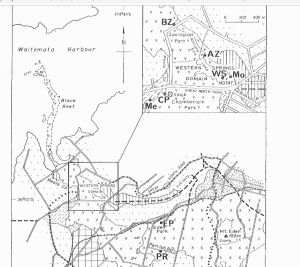
Their map shows Western Springs and Chamberlain Park as one continuous area. According to the Auckland Unitary Plan Western Springs Aquifer has water availability of 9.6 million cubic meters per year, and is the largest aquifer under the protection of the Auckland Council [1]. From 1877-1910 this aquifer and springs provided Auckland city’s main water supply [2]. Russell and Rogers measured the flow of the Chamberlain Park spring as about 25% of the flow in Western Springs domain, a sizable volume of water.
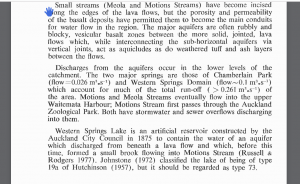
[1] Nov 2016 Auckland Unitary plan http://unitaryplan.aucklandcouncil.govt.nz/Images/Auckland%20Unitary%20Plan%20Operative/Chapter%20M%20Appendices/Appendix%203%20Aquifer%20water%20availabilities%20and%20levels.pdf
[2] https://en.wikipedia.org/wiki/Western_Springs
[3] STEPS 2018 Western Springs action
Like this:
Like Loading...
Liz July 3rd, 2019
Yesterday STEPS and our friends the Freelance Moth Plant Removers had a third session in a large property at the top of the Waititiko Meola catchment. Margaret and Camilla worked around the wetland; Jeremy and Oliver worked back along the watercourse (source of Meola Creek), and Jean, Keith, Sel, Neil, Shannon and Liz went along the western boundary to remove moth plant pods before they could burst. We hope we prevented millions of future plants!
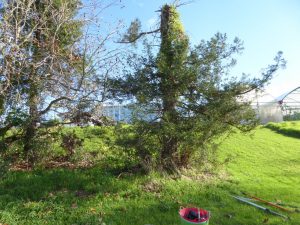
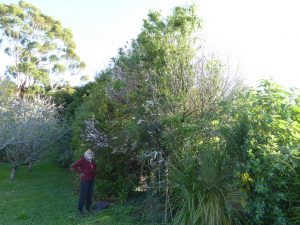
The weeds had become entrenched since the gardener of many years moved on. Both moth plant (Araujia hortorum) and woolly nightshade ( Solanum mauritianum) are listed as pest plants by Auckland Council. We plan to soon finish off many woolly nightshades which are still there in order to provide the owner with a clear starting point for containing these weeds. Unfortunately each araujia pod may have 1000 seeds and the ground will now be covered in seedlings for many more years.
The top of the catchment is a critical point for transmitting weeds down to the neighbours and wider catchment. This is the last of four large watershed properties to commit to managing weeds and we have been delighted by the enthusiasm of staff volunteers. Because we don’t want to repeat this effort here we now plan to work with the gardening management and team to prevent recurrences.
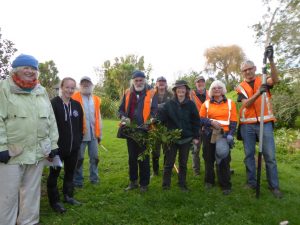
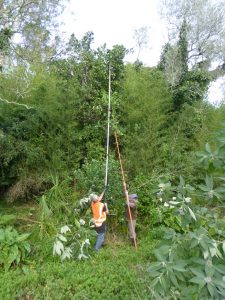
Thanks so much to Jean who organised us and provided photos; and to Keith and those who brought gear; Shannon for materials and for joining us and of course our large professional gang who did all the work – the largest so far according to Jean!
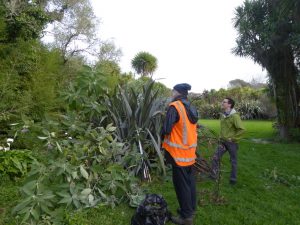
“They also serve who only stand and watch admiringly”😃
Like this:
Like Loading...








